Camille Saint-Saëns (1835-1912)
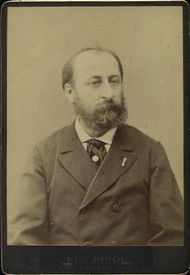
Opus 78: Symphony no. 3, in C minor (“Organ”)
composed: 1886 (age 51)
published: 1886
first performance: London, May 19, 1886 (Saint-Saëns conducting the London Philharmonic Society)
dedicated to the memory of Franz Liszt
Score can be studied, but not easily downloaded, here.
343 on the list.
Because of Babe (and, by extension, these dudes), I used to think of this as a piece with a sweet spot, a single sparkling moment at the top of the last movement, surrounded by satisfactory but unmemorable conventionality. I managed to think of it that way even after recognizing that the “sweet spot” is just one incarnation, neither the first nor the last, of a flexible motive that undergoes development throughout the entire symphony. The entirety of the piece preceding the sweet spot played as an elaborate anticipation of the sweet spot; the remainder as an obviously failed attempt to sustain its glory.
Now that I’ve heard the whole piece some twenty or thirty times, the sweet spot dims and takes its proper place in the form. It’s certainly not an unsweet spot, but it’s not the point of the piece either. Babe and I were partially right all along: yes, that moment is sort of a prophecy fulfilled, and yes, it’s sort of an announcement of victory. But the “prophecy” feeling is really only meant to function retroactively; the other movements really do stand on their own and don’t have any particularly anticipatory feeling to them. And the even more bombastic stuff at the very end is meant to trump the sweet spot. Which is very clear indeed when you’re listening to it straight through without any prior knowledge of “If I Had Words.”
Saint-Saëns’ reputation is for facility, in both the positive and negative sense. (Or can you only use “facile” in the negative sense, not “facility?” Well then, Saint-Saëns’ reputation is for being very talented but writing facile music.) But I’m not sure that reputation is borne out by this piece, which certainly feels craftsmanly in many ways but is hardly a slick, seamless piece of work. Throughout, he can be heard taking unusual risks, not all of which pay off. His struggles to achieve formal and aesthetic balance are fairly apparent; the piece does not “make it look easy.”
This sounds like a criticism but I mean it as a defense against the accusation that the music is superficial and glossy. I enjoy that the piece is actually a string of idiosyncracies, some of them awkward; it helps give value and definition to the passages that are both slick and conventional, and imbues the whole with a sense of human ambition that I find sympathetic, if not always necessarily successful.
He has some kind of big idea about how the four movement scheme has been subsumed into a two-movement scheme because the 1st and 3rd movements lead semi-smoothly into the 2nd and 4th movements; but the actual effect is fairly local and negligible, if you ask me. Maybe by having had no actual “big finishes” prior to the 4th movement, he thinks he’s justified a final mega-parade of big finishes. I’m not so sure.
The theme of the first movement seems like some kind of reference to Schubert’s Unfinished Symphony, not clear why. The syncopated effect in the strings starting on page 5, it would seem, is near impossible to play with exact precision. Or else conductors just don’t prioritize it – I don’t think any of the recordings I heard were able to keep that texture truly crisp. I can imagine that the rehearsal-time-to-impact ratio is much too high in almost every situation; I would therefore class this as poor judgment on the composer’s part. The second theme is weakish in the way that everything I’ve ever heard by Franck seems weakish; and the development, based mostly on transitional figures, verges on the dull. Then it suddenly lurches out boldly in a way that maybe it hasn’t earned. All that said, I have driven this piece deep into my brain and will cheerfully listen to the entire movement, humming the whole way through. It doesn’t really make a solid argument for or about anything but just listen to how vigorous those strings are! “If that ain’t a symphony I don’t know what is!”
The theme of the slow second movement (first movement part 2, in Saint-Saëns’ scheme), is both beautiful and “beautiful.” This is not the only respect in which it is comparable to Saint-Saëns’ mega-hit, “The Swan.” Of the two I think the present melody is superior. Actually, it sort of sounds like an inversion of “The Swan.” Has anyone else pointed this out?
The nicknamular organ enters in this movement for a unique atmosphere. An organ generally suggests worship and cathedrals and all that, but I don’t actually get that here. To me this is more like an intense lullaby, something so warm and soothing that it’s unearthly. The organ puts us not in a church but underwater, or in utero. The melody, in this context, is like the kind of too-simple tune that lingers from my dreams sometimes when I’m waking up – it seems more laden with emotion than something this bare has any right to be. I get this sense of “the uncanny within the mild and hummable” from Puccini, too, whose melodies this resembles. His supposedly “beautiful” tunes have an unnerving not-actually-casual quality; like someone has lifted up the skin of a salon song and we are looking at its concave face from the inside. Whew, how horrific.
I’m talking especially about the part of the melody at rehearsal “R” in the score. I wouldn’t be shocked if Saint-Saëns just meant this to be baby Jesus in the manger or something like that, but to me there’s something dizzying and dreamy about it. Although I suppose for a lot of people there’s something dizzying and dreamy about baby Jesus, too. Anyway, that’s probably the most successful movement.
It’s not like me to pick the slow movement!
The third movement (i.e. second movement part 1) is built on awfully thin material. I guess that’s how Beethoven scherzi are too, and I think Saint-Saëns had Beethoven very much in mind. The whole symphony is, and I’m not exactly making this up myself, a French composer’s aspiration to a more Germanic, Beethovenian form and tone. This third movement is where the borrowing feels most forced. The counter-material is of course the recurring motive from the first movement. Once you’ve noticed that – and you notice it immediately – the movement’s pretty much played all its cards. Then comes the zany trio, which seems to be built out of exploded bits of the rest of the movement. Program notes will invariably mention the appearance of a piano playing rapid scales, but will avoid talking about why this happens, because no matter how many times you hear it, it’s really, really nuts. I respect Saint-Saëns for doing this. Also, the swoopy second theme of the trio is delightful. Don’t know what it has to do with anything else but who cares. It’s comedic in a wry and graceful way and that comes as a pleasant relief.
Then comes the sweet spot (at page 126) preceded by some flagbearers and a guy on a unicycle, which starts us off into the final movement, the most ambitious and sloppiest of all. It took me several listens to realize that the movement is in totally standard sonata form and that the “sweet spot” theme – which, incidentally, is in a flowing 9/4, where it makes sense, and not the confusing quirked-up 4/4 of the reggae version – is actually recapitulated later (just after “AA”). But during the recapitulation, it’s intentionally hobbled – he kicks the legs out from under it so that it flops over prematurely each time it’s stated. This presumably is to maintain a sense of suspense until the very end, which is attended by gargantuan bombast. The whole movement is bloated, and then it ends with a tiered celebration of ascending bloat, a finale that’s very hard for conductors to pull off. There’s a metrical experiment of sorts going on, where the pulse gets only slightly broader while the notation gets vastly broader, and that seems to confuse musicians. The only conductor I heard who had the ending fully in hand was von Karajan.
Dubal’s recommendations were
M. Dupré, Detroit Symphony Orchestra, Paray: Mercury 432719-2
Raver, New York Philharmonic Orchestra, Bernstein: CBS MYK 37255
Alain, Vienna Symphony Orchestra, Prêtre: Erato 2292-45696-2
And my favorite recording of the piece overall was indeed the Paul Paray / Detroit one, which I found appealingly direct throughout. The Bernstein / New York recording isn’t particularly distinguished. I couldn’t find the Prêtre / Vienna recording anywhere – here begin my struggles with Dubal’s frequently obscure recommendations – though I did end up buying another Prêtre recording of the same piece, in confusion. Different performance, and not a spectacular one either.
My second choice, and maybe it would be my first choice if I really side-by-sided them, is Charles Munch and the Boston Symphony Orchestra. And third comes the von Karajan, which is cold but in a suitably Beethovenian way, and stands head-and-shoulders above the rest in terms of making sense of the score on the whole. He cleans up every mess with ease.
Again my favorites were the oldest two.
Overall review of the piece: This piece is flawed in several ways, and it saddened me when I read that Saint-Saëns said something like “I did things there I will never be able to do again.” Why didn’t he keep aspiring onward in this direction? I think he would have in fact done better the next time around. The piece is full of appealing details and for all its shortcomings, I’ve made friends with it. I’m just not about to open up to it; I have smarter friends for that.
Beth, I can tell you, didn’t like it.
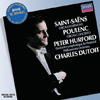
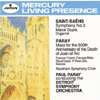
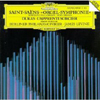
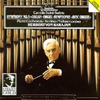
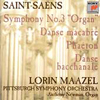
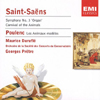
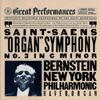
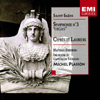
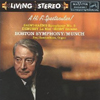
In the order they appear above, with dates of recording. Many of these album covers (and Dubal) name the organist like he’s an important soloist but please. There’s nothing soloistic about it. So I don’t name the organists below.
Orchestre symphonique de Montréal / Charles Dutoit. Decca 475 7728 7 DOR. 1982.
Detroit Symphony Orchestra / Paul Paray. Mercury Living Presence 432 719-2. 1957.
Berliner Philharmoniker / James Levine. Deutsche Grammophon 419 617-2. 1986.
Berliner Philharmoniker / Herbert von Karajan. 439 014-2. 1981.
Pittsburgh Symphony Orchestra / Lorin Maazel. SK53979. 1993.
Orchestre de la Société des Concerts du Conservatoire / Georges Prêtre. EMI 5 74753 2. 1964.
New York Philharmonic / Leonard Bernstein. CBS MYK 37255. 1978.
Orchestre du Capitole de Toulouse / Michel Plasson. EMI 5 56362 2. 1995.
Boston Symphony Orchestra / Charles Munch. RCA 09026-61500-2. 1959.
I didn’t like the piece, no, but YouTube is awesome, isn’t it?